Travels of a Bengali foodie
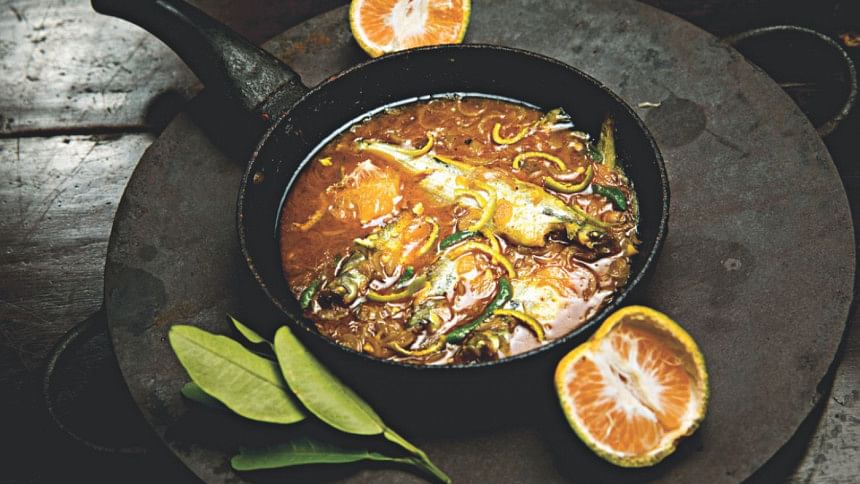
While it is possibly an academic exercise to search for roots, the end result of this has made our tradition richer, and varied.
Perhaps, this diversity is most evident in the culinary heritage. A nation known for their love of fish, has various signature dishes particular to areas loosely because of the origin and the flowing pattern of the rivers; fish of ponds gave a distinct taste. In regions where there were no rivers, meat dishes took over!
And as for vegetables, the seasonal variations are simply unmatched. When one takes all these into account, we are left with a treasure-trove of food heritage.
Another nuance of Bengali cuisine is that there are no recipe-books, there are no measuring spoons, beakers — the magic wands of our cooks are simple hands, and lifetimes of experience, and that only!
In the following recipes, I have made no attempt to suggest portions as it is possibly intuitive. Mastering these dishes is as much a trial and error, as it was your first 'bosha bhaat.'
CHINGRI BHORTA –MASHED SHRIMP (JESSORE/KHULNA)
Just about every region has a version of chingri bhorta. It is a tasty dish with a very simple preparation. First, take small or medium shrimps out their shells. Then lightly boil those in water with few whole dry peppers, a bit of kalo jeera (nigella seeds), garlic and salt. You can substitute kalo jeera with mustard seed, but that will slightly change the taste of the preparation.
After boiling, fry in a little oil. Many prefer to add a bit of grated coconut while frying. As soon as the fried shrimps give off the aroma, take it off the stove and crush the fried shrimps. If you crush these by hand, the bhorta will have a grainier texture. Add chopped onion, green chillies, coriander leaves with mustard oil and mix thoroughly. You can also add a bit of sliced ginger in the bhorta.
MUNG DAAL WITH ILISH HEAD (KHULNA)
You can start by frying the mung daal or use it raw. Slightly boil those with a ginger, garlic, turmeric and salt. In between, make a bhuna of the hilsa head.
You can also add a bit of the fish's tail and gill with the head. To increase the taste, sometimes breaking the head a bit enhances the flavour. Since fish bones are an issue, keeping the head whole maybe a better idea. As the bhuna is finished, mix it with the previously prepared moong daal. Before serving, sprinkle a dash of chopped green chillies and coriander leaves.
Note: Bhuna means all the spices are fried in very hot oil; then fish or meat are added into and cooked in their own juices without any water, the closest English translation of 'bhuna' is 'browning.'
MEAT WITH CHUI JHAL/ PIPER CHABA (KHULNA)
Travelling from Jessore to Khulna, if you are one of those who have never had goat meat with chui jhal from Abbas's restaurant, you have truly missed out on an exceptional dish!
At first glance, chui jhal resembles cinnamon or a piece of tree bark. The plant is a creeper that adheres to primarily mango trees for sustenance. The ingredient is found in the southern regions of Bangladesh, so cooking with it is a specialty of these places. Storing chui jhal for longer periods of time makes it loose its sharp taste and smell.
Both beef and mutton can be prepared with chui jhal. You have to cut the dried chui jhal fruit like cinnamon pieces after washing it first. Pour oil in a pan and put the meat in it. Take one kilogram of goat meat and cut the meat in larger chunks. Then add a cup of thickly chopped onion, one teaspoon each of garlic and ginger paste; cumin, coriander, turmeric and chilli powder, add salt as needed. Also add a few cardamoms, cinnamon pieces, cloves and whole peppercorns and mix all these with the meat. Pour a little water and cook in medium heat while stirring occasionally.
When it boils a bit, add half a teaspoon of powdered methi (fenugreek). Too much of it will make the dish bitter.
While stirring, add peeled garlic and the chui jhal. Continue stirring while lowering the heat. Meanwhile the garlic will boil and the chui jhal will soften. Stop cooking when the oil finally separates. Right before taking the cooking pot off the stove, add a teaspoon of powder, garam masala and radhuni (wild celery seed) powder.
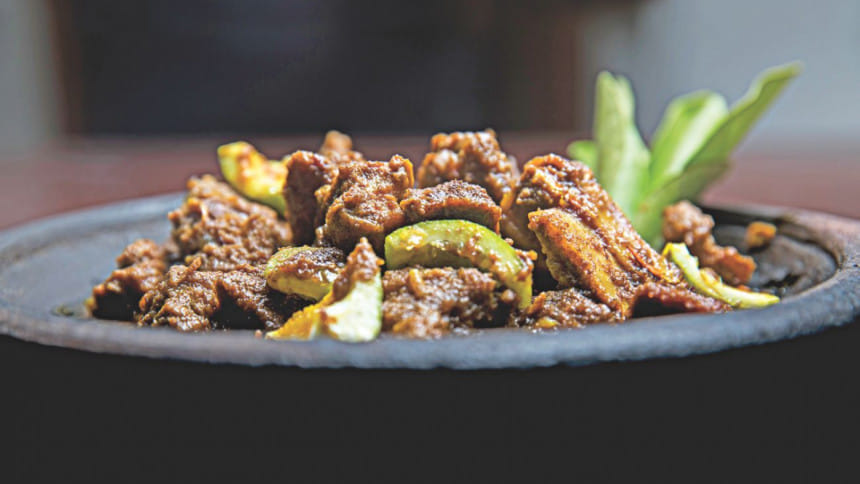
ILISH HEAD BHORTA (MYMENSINGH)
Break off a part of the ilish head, you can also add tiny pieces of the gill, eyes, tail and mix them all with turmeric and salt to fry them. While frying, also add some green chillies and garlic. After frying is done, mash these to a fine texture. If any unmixed part or fish bones are found, take them out. Only take the finest parts for the bhorta. Now mix it properly with chopped onions, chillies and mustard oil.
ALUR DAAL – POTATO CURRY (RANGPUR/DINAJPUR)
Although the name has reference to potatoes and lentil, the dish is neither lentil with potato, nor is it potato with lentil! It is a simple potato dish.
Boil five to six large potatoes and break them in half. Put some oil in a pan and heat the oil on medium heat. Add panch phoron (five spices mix), bay leaves and dry chillies to the oil. Add ghee if you want to enhance the taste. Put in chopped onions, ginger, turmeric and salt, while stirring for some time. Then add the potatoes and lower the heat. If needed, add water by the teaspoon to avoid burning the curry. After eight to ten minutes, pour water as needed. Let the curry stew on medium heat while covering the pot.
When the curry boils a bit, check the density. It's fully your preference on how dense you want the curry to be. As the curry reaches the preferred density, add a little bit of sugar and powered cumin.
If it's winter, you can ripe tomatoes when it is stewing. In this case, you can add chopped coriander leaves and split chillies instead of the cumin. For a sweet-and-sour flavour, add bit of tamarind. This tastes excellent with rice, paratha, luchi and roti. In Rangpur, boiled eggs are added to make it a completely different and tasty curry!
PALKA SHALKA – VEGETABLE SOUP (RANGPUR DIVISION)
This is one of the most favourite dishes from Rangpur, which is somewhat similar to a vegetable soup.
Add sajne (moringa) leaves, kochu (taro) leaves and pui shaak (Malabar spinach) together in a half litre or a bit more water. Add crushed ginger, garlic and green chillies with salt and set it to boil on medium heat. As it boils, add half a teaspoon of baking soda. Before setting down, add chopped coriander leaves. When it finally reaches the thick consistency of a soup, take it off the stove.
In Rangpur, this is made mainly with nafa/lafa shaak (Chinese mallow), bothua shaak (white goosefoot), and barb/Babura shaak (chopsuey green). Mashed potatoes and beef bhuna are often eaten together with palka shalka.
COOKED FISH WITH SHIDAL BHORTA (GREATER RANGPUR)
Shidal is prepared by wrapping small fishes with taro leaf and keeping it under soil after inserting in a clay pot. This results in an acrid smell, which is the main appeal of the dish
The fish looks a lot like a disc of compact soil, round shaped and grey. Wash it properly before cooking it. Flatten it with your hand and put a pan on the stove with some mustard oil. Now fry some garlic, chillies and ginger on the pan. After frying these, make a paste of all these with the shidal. Now if you mix it with mustard oil and salt, it will be ready to eat.
Snakehead murrel and spotted snakehead fish are often preferred to cook shidal. Once these two fish are nearly cooked add shidal to it and close the lid. When the oil separates from the spices then take it down from the stove.
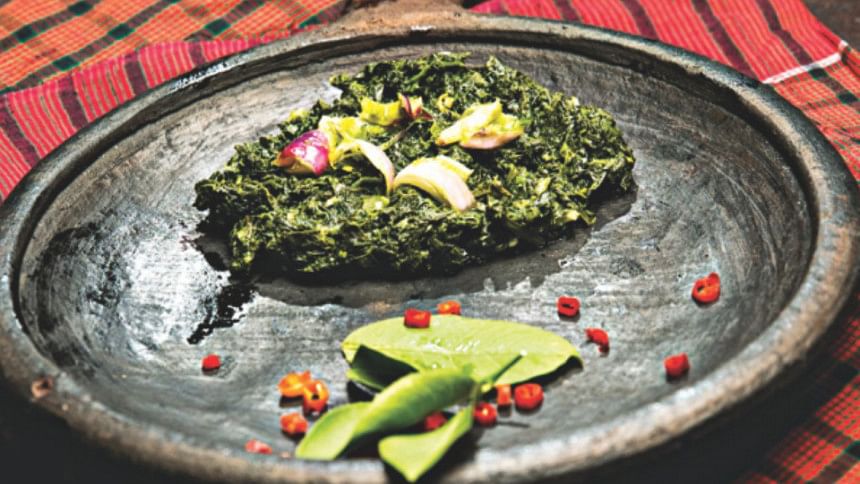
FIGS WITH COCONUT MILK (KHULNA/JESSORE/BAGERHAT)
Fig flowers or dumur er phool has a special place in Bangla; fabled like a unicorn. This time the focus is on the fig itself and cooking with it. Fig is found in parts of Khulna and Barishal District, and these places also grow a good amount of coconut.
Cut the figs like olive, and mix with salt and turmeric; steam the figs until the water is removed. Then pour a little oil in a wok and add ginger paste, green chilli paste and garam masala paste. After that add the figs and start cooking by adding some water in small amounts.
After cooking on a low heat for some time, pour in coconut milk. Keep it on low heat for a little longer with a lid and then take it off the stove.
DUMRO MURGI- CHICKEN WITH WHITE COCONUT MEAT (KHULNA)
Dumro refers to the ball like white part in a coconut. The dumro forms when the green young coconut starts maturing. In winter, you can find this being sold on the streets.
Slice the dumro into long thin pieces. Cut the chicken into small pieces and cook with a bit of cumin, ground coriander seeds (dhoniya powder), garlic and ginger paste and green chilli paste. The amount of ginger and chillies need to be more than average, do not use turmeric. As the oil separates from the meat, add the dumro and stir. As the cooking ends, adding a bit of coconut milk will enhance the taste.
TARO, COCONUT AND TAMARIND LEAF BHORTA (JESSORE)
Make a paste of the upper portion of the taro (maan kochu), make paste of the coconut as well as mustard and green chilli. Mix everything together with salt and make the bhorta.
According to folklore, the tamarind (tetul) tree is usually haunted by ghosts! But that does not make the tamarind leaves any less flavourful. It tastes unparalleled as a bhorta. The preparation is easy, although getting the leaves may prove difficult.
The tamarind leaves have to be dry grilled in a wok. Then wash them and make a paste with garlic, onion and green chillies. Mix it with mustard oil to finish making this tasty bhorta.
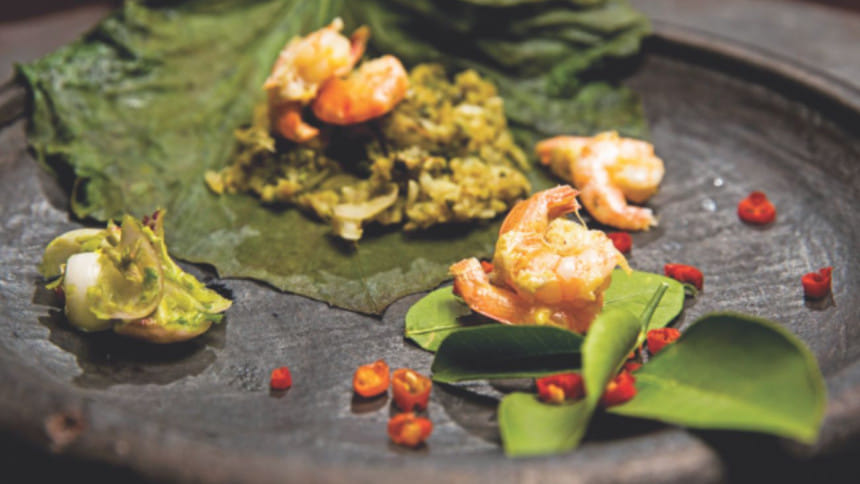
TOMATO KHATTA — SWEET AND SOUR TOMATOES (MYMENSINGH)
Take half a kilogram of ripe or half-ripe tomatoes and slice them, mix those with turmeric and salt. Start boiling these in a litre of water. Crush two large garlic's in it and some green chillies. This khatta will smell of the garlic and the chilli. If you do not prefer the heat, lower the amount of green chillies. Small pieces of two or three ruhi (carp) fish into this. But if you do not prefer the fishy smell, then no need to add that. As it boils down on a medium heat and thickens, lower the heat. Tomato khatta is usually quite light, and thin in consistency.
MOIRCHA BEGUN AND SHUTKI WITH SMALL POTATOES (MYMENSINGH)
Moircha begun is a special egg plant from the Mymensingh region. Cut the eggplants lengthwise into fours. Cut the potatoes into halves. Cook the shutki and make it spicy. As the shutki finishes cooking, add the eggplants and potatoes with a little bit of water and put in on low heat with the lid on. Stir occasionally and take care that it does not stick to the bottom of the cooking pot. Stop cooking when the potatoes boil.
CHICKEN WITH GINGER ON BANANA LEAVES (ETHNIC STYLE)
Cut chicken into small pieces. Other ingredients for this dish include a good amount of ginger and ginger paste, lots of green chillies cut lengthwise, and a bit of chopped garlic with soybean oil as needed. Use all the spices to rub into the chicken and set aside for a little over an hour. Then wrap it in banana leaves and set on a wok with a lid on medium heat. The wafting aroma of the ginger will signal the end of the cooking. During cooking, turn over the leaves from time to time. You can check after half hour to see if the meat is cooked through.
The same cooking can be done inside a bamboo stalk. If you do not have banana leaves, foil paper can work as a good alternative. This is a tasty, spicy chicken dish and is very popular.
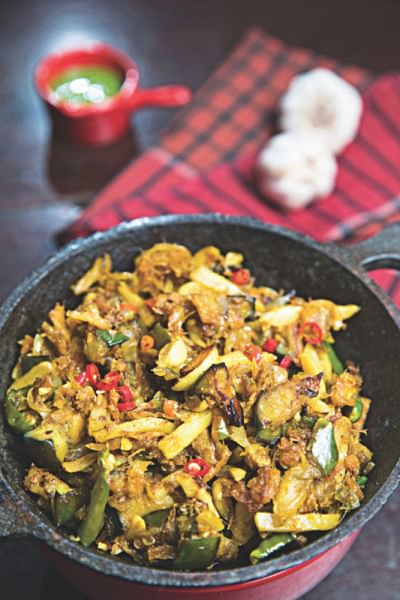
TOK MOSHUR ER DAAL — TANGY LENTIL (Narsingdi)
Boiling the lentil in pressure cooker with salt and turmeric is the best way to go. A large pot with lots of water will also work the same, boiling it will just take longer. The more this is boiled down, the tastier it becomes. As the daal thickens, add a whole sweet and sour plum or olive. As it thickens even more set the daal aside and prepare for the 'baghar', or tempering.
In a wok, pour soybean or mustard oil and add dry chillies and mustard or dry chillies and nigella seeds, stir until the aroma fades and add the daal. This daal is meant to have a thick consistency.
MEAT COOKED WITH SATKORA/WILD ORANGE (SYLHET)
Throughout the entire region of Sylhet, cooking with satkora is popular. This fruit resembling a lemon is exclusively found in that region. It has a bitter taste but the aroma is sweet, almost like a lemon. Before cooking, the bitter taste has to be taken care of; otherwise the curry might turn inedible. To decrease the bitterness, cut it into pieces and dry those in the sun.
Both beef and mutton can be cooked with this. The meat has to be cut into large chunks. Then rub the meat with ginger, garlic, cumin, turmeric, chillies and add to oil with chopped onions. Cook like any typical meat dish by adding water little by little. As the cooking finishes, add the pieces of satkora. Stir carefully so that the pieces do not break. You do not have to add garam masala when cooking with satkora as it has its own fragrance.
PABDA/OMPUK FISH WITH ORANGE PEEL (SYLHET)
Start off by adding typical spices for cooking fish. Instead of using dried chillies, fresh green chillies will improve the flavour in this case. Use a lower amount of garlic as the smell of the garlic can overpower the sweetness of the orange. As the cooking finishes, add the orange peels and set aside for some time before serving. The orange peels have to be prepared 2-3 days beforehand by chopping them up and drying them completely to get rid of the bitter taste. Also, other than pabda, any other fish can also be cooked with orange peels.
AUBERGINE WITH EGG (FARIDPUR)
Take one or two large aubergines (often called Gafargaon begun) and grill whole over a flame. Then peel off the skin and cut into large chunks and mix with two eggs, turmeric and salt. Pour in a good amount of oil in a pan and start stirring with chopped onions, ginger, garlic, cumin and coriander. Add water in small amounts so that the ingredients in the oil do not stick to the bottom of the pan. After stirring for some time, add the aubergines and start stirring fast. While stirring, the eggs and the spices will mix through. Cook in low heat for 10 minutes and stop as the oil rises.
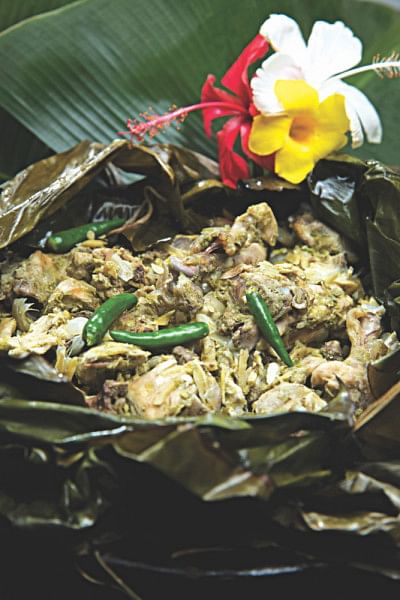
PRAWN BRAIN BHUNA (BAGERHAT)
Prawn bhuna or malaikari are pretty popular. But it is hardly imaginable that the brain of the Golda chingri or prawn can be a delicacy as well. In the Khulna-Bagerhat region, this brain is sold separately for a regional preparation.
Take the brain and wash lightly and carefully in a colander. Add oil in a pan and brown some onion in it. Then add chillies, turmeric, cumin, garlic and ginger until it is tempered. As the oil separates and rises, add the brain. The heat has to be kept low. Start adding water by the teaspoon and wait for the oil to rise. The dish will have a spicy taste.
TILLI BHORTA — MASHED SPLEEN (NILPHAMARI/PANCHAGARH)
Tilli or spleen is the soft black part attached to a cow's liver. You can cook it, or have it as a bhorta. But the bhorta is delicious in its own way.
Wash the spleen and grill it over a flame. Often this is done over a wok. Take a small amount of oil in a pan and lightly fry a good amount of garlic and green chillies. Then take the grilled spleen, and the fried ingredients and mash them together either on the pata or with mortar and pestle. Before finishing, add coriander leaves and pudina (mint) leaves and continue making the bhorta. Add chopped onions, mustard oil, and green chillies. With rice, this is an excellent dish.
By Shahana Huda
Translated by Iris Farina
Photo: Sazzad Ibne Sayed
Food styling: RBR





Comments